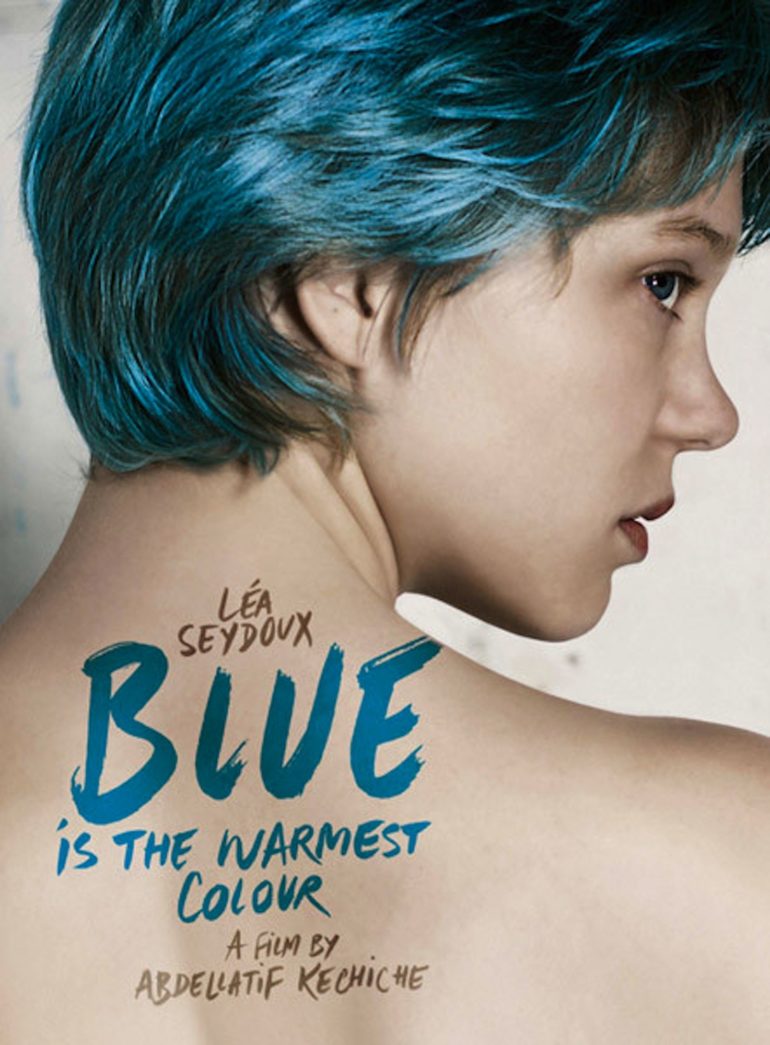Adèle (Adèle Exarchopulos) is a teenager living in Lille. She goes to school, ponders over 16th Century French literature and discusses boys with her friends. However, Adèle is hampered by a lack of passion and contentedness she cannot explain. She dates a boy her own age and has sex for the first time but shortly after calls off the teenage romance. While walking in Lille’s city centre she spots the confident, blue haired Emma (Léa Seydoux) and is transfixed by her. She fantasizes about her despite not confronting her sexuality. She eventually follows her after another chance encounter to a gay bar where they strike up a conversation and an immediate connection is formed. They then embark on a passionate love affair that spans over several years while Adèle comes to terms with who she is and where her place in life is.”
Blue is the Warmest Colour or La Vie d’Adèle – Chapitres 1 & 2 is a difficult film to synopsise but far from difficult to be enchanted by. Adapted from the graphic novel by Julie Maroh, writer-director Abdellatif Kechiche crafts a unique and engrossing film. The three hour running time is a daunting prospect walking into theatres but Kechiche manages to keep this film at a seamless pace. The long scenes are far from arduous or over staying their welcome. Scenes that end focused on Adèle unglamorously fast asleep at first is voyeuristic and uncomfortable but a sense of intimacy is established with the heroine long before her clothes come off. By spending three hours with Adele from her late teens to early adulthood we develop a bond that is incredibly rare in modern movies. Exarchopulos’s performance is a revelation for a début as we see her faults, her contradictions, and her confusion in an unmistakably truthful fashion. Seydoux is less vulnerable but her confidence on screen is magnetic and she conveys all the mysteries of lust and passion to Adèle in one single look.
The controversy surrounding the film’s explicit sex scenes is no doubt shrouding this film unfairly. Adèle and Emma’s first time sleeping together is long and uncompromising and simply one of the most explicit sex scenes committed to celluloid. One wonders if the director has gone too far and asked too much of his actors. The sex scenes take up in total maybe 15 minutes of screen time in a three hour picture but many will see and talk about this film based on that fraction. There are arguments for and against the salacious nature of the eroticism on whether it veers too close to pornography and its merit and purpose. There also may be an indifferent sigh form the gay community as this is a film directed by a 50 year old man with two heterosexual leads. What can’t be denied is the commitment to the piece from the actors’ performances and by no means does the film get overshadowed by a somewhat misguided over reliance on eroticism.
The film is directed with lush and vivid colour. The blue motif is immediate and recurred throughout. Direcor Abdellatif Kechiche also frames his lovers in one of the most romantic shots in film as their lips meet in front of the sun and are lit with a warming glow. Kechiche conveys the societal conflicts in an almost effusive way. The issues are never really discussed in the film but they are persistently in the background. Adèle is chastised and ostracised for simply being in a gay bar rather than staying with the handsome boy who is head over heels about her. She also never reveals to her family and close friends she is in a relationship with another woman. Her parents insist on her choosing a profession with stability and promise rather than the heart while Emma as an artist never conforms to a traditional path or lifestyle. Kechiche and screenwriter Ghalia Lacroix beautifully capture this dichotomy through two dinner scenes: Adèle’s family have the old reliable spaghetti Bolognese, while Emma’s bohemian family opt for oysters. This mise en scene may be unsubtle but it beautifully and simply conveys the class divides that are hinted at throughout the film.
Blue is the Warmest Colour is a difficult film to pigeonhole. It’s a tragic romance, it’s a coming of age drama; it’s a film about sexual awakening; and it is an examination of modern France and its socio-political fabric. There are quieting moments of heart rendering tenderness, profound poignancy and lingering sadness which will echo in your bones for a long time. Another category this film will surely fall into is one of the year’s best and simply: unforgettable.

